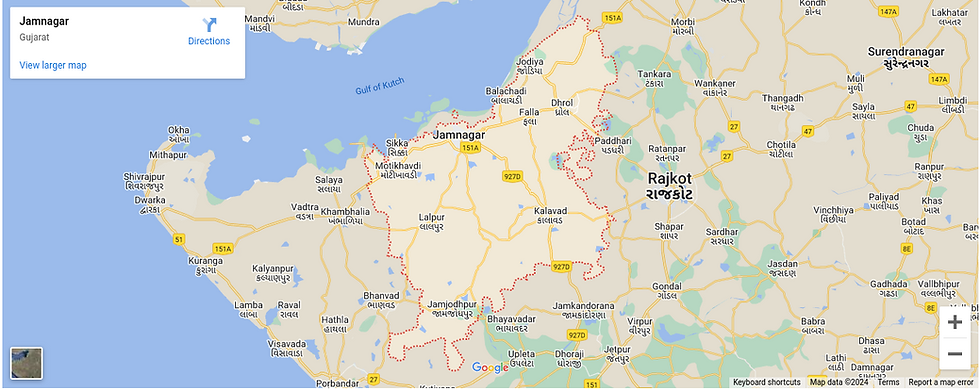Preliminary Insights and Action Plan to Address Vaccine Hesitancy in Jamnagar District
- hymab2
- Jun 17, 2024
- 4 min read
Updated: Jun 25, 2024
Field Visit and Insights Report,
Jan 25, 2024
Context
Jamnagar is a district of Gujarat in Western India. It hosts production facilities of large Indian companies such as Reliance Industries. There are seven administrative divisions with a population of about 6 million (according to 2023 rough estimates), roughly equal to the nation of Namibia. The sex ratio is 938 females to 1000 males, with a literacy rate of 74%, with Gujarati as a predominant language, followed by Kachchhi. Schedule Caste (SC) constitutes 7.3% of the total population in Jamnagar, while Schedule Tribe (ST) is 0.9%. 18.99% of the total population is Muslim.

Figure 1: Political map of Jamnagar district with all taluka
Current Scenario
About 1200 in Jamnagar district and 700 in Jamnagar Municipal Corporation (JMC) have been identified as vaccine-hesitant families for uptake of Routine Immunization services. Clusters of families where children are dropped out of immunization have been identified. The majority of the population belongs to minority communities of Muslims and Tribals, consisting of denotified tribes - Banjara and Vagher communities. Most of the population are daily wage labourers employed in nearby Brass factories. Fisheries and marine resources constitute another essential source of livelihood for these communities.
Problem Statement
The RI vaccine hesitancy among these families and its impact on child health and survival.
This requires an understanding of:
The context and interactions influencing decision making regarding vaccination of children
Potential barriers and drivers for vaccination uptake.
Perspectives of the healthcare workers (HCW) - MO, ASHA, ANM and roles towards driving of vaccination services
Quality of healthcare service in UPHCs
Developing behaviourally informed interventions to reduce vaccine hesitancy such as message framing on importance of vaccination, strengthening community engagement, leveraging existing community platforms and groups, providing information and enabling greater trust on the healthcare service providers.
Context Perception & Vaccine Hesitancy

Figure 2: SAP Lab team in conversation with Govt. health workers and medical staff of Jamnagar.
Meeting with MoH, Jamnagar Municipal Corporation and 25 Medical Officers (MO) was organized by the SBCC team from the Social Action and Policy (SAP) Lab, IIT Gandhinagar, with oversight from UNICEF and Gujarat Health Behavioural Insights Lab (GHBIL), SHSRC. As per the MO’s, RI vaccination is perceived as not necessary among the communities, due to
Lack of relevance: Mothers and the families are not aware about the benefits of vaccination or its importance so taking the child for vaccination is not relevant for them.
Low ANC/ASHA visits: Irregular ANC/ASHA visits due to shortage of man power has hampered the counseling and education regarding vaccination, hampering the uptake.
Fear of side-effects and pain: Fear of pain caused due to injectable syringes and side effects (fever) resulted in avoidance of uptake of vaccine and drop-out after first dose or MR dose.
Lack of Influencers: Mother may not be reluctant to get her child vaccinated, but avoiding it owing to guidance from their families or community.
Mental model: a prevalent mental model (based on secondary data from MO’s) indicate that needless vaccination should be avoided due to wage loss, guidance from families and lack of trust on healthcare provider.
Beliefs regarding the impact of vaccines on the child hence difficulties in completing the immunization schedule leading to drop-outs.
Suggested Action Plan
Based on the above insights, SAP Lab team can provide technical support to Jamnagar Municipal Corporation in implementing a SBC driven strategy for increasing vaccine uptake. SAP Lab can support in suggesting an action plan, list of activities, conducting capacity building of relevant stakeholders and providing communication packages to Jamnagar Municipal Corporation for driving intensive community engagement drives for the next week. Below are some of the activities suggested based on preliminary data.
Stakeholder Mobilization and Engagement
• The Social Action and Policy (SAP) Lab has mobilised 15 NCC cadets present in Jamnagar. SAP Lab and GHBIL can conduct a training session with NCC cadets to spread vaccine uptake awareness. The NCC cadets can conduct rallies and door to-door messaging on 28, 29, and 30 January in two clusters where resistant families are high - Bandar Road and Panvada.
• The SAP Lab can support JMC in mobilising medical students from Shri MP Shah Government Medical College and conducting Sheri natak on addressing vaccine hesitancy and creating awareness on RI.
• The SAP Lab can support JMC in organising meetings with local industry associations, construction site owners, fishery associations, and brass industry associations to disseminate SBC communication materials and promote vaccine uptake at their sites.
Leveraging Existing Community Platforms
• Mahila Aarogya Samiti members can be mobilised by MOs to conduct awareness sessions with the communities and counselling on vaccination. SAP Lab and GHBIL can support the provision of communication materials to the Samiti members.
• MOs can be supported in disseminating SBC-driven IEC materials to the ASHA and ANM catering to these specific pockets.
• Faith leaders/Aagevaans can be reached out as crucial influencers in disseminating messages on the importance of vaccination.
Conclusion
The MoH must lead the implementation of this action plan, leveraging its resources and workforce to ensure the sustainability of the interventions. The short-term goal is to create awareness so that the maximum number of children and families turn up for vaccination on a particular RI drive on 31st January 2024. SAP Lab, GHBIL, and UNICEF can support the stakeholders in providing technical assistance, designing targeted SBC messaging, and capacity building.
